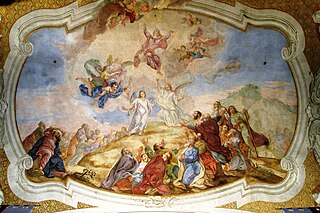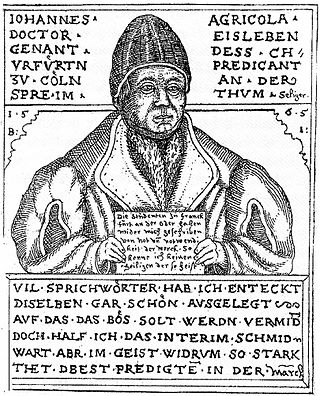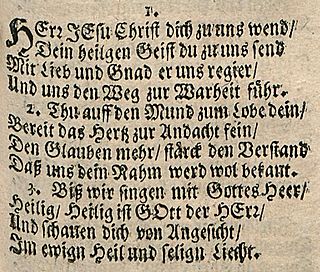The Bach-Werke-Verzeichnis is a catalogue of compositions by Johann Sebastian Bach. It was first published in 1950, edited by Wolfgang Schmieder. The catalogue's second edition appeared in 1990. An abbreviated version of that second edition, known as BWV2a, was published in 1998.
The Neumeister Collection is a compilation of 82 chorale preludes found in a manuscript copy produced by Johann Gottfried Neumeister (1757–1840). When the manuscript was rediscovered at Yale University in the 1980s it appeared to contain 31 previously unknown early chorale settings by Johann Sebastian Bach, which were added to the BWV catalogue as Nos. 1090–1120, and published in 1985.

The Orgelbüchlein BWV 599−644 is a set of 46 chorale preludes for organ — one of them is given in two versions — by Johann Sebastian Bach. All but three were written between 1708 and 1717 when Bach served as organist to the ducal court in Weimar; the remainder and a short two-bar fragment came no earlier than 1726, after the composer’s appointment as cantor at the Thomasschule in Leipzig.
Throughout his life as a musician, Johann Sebastian Bach composed cantatas for both secular and sacred use. His church cantatas are cantatas which he composed for use in the Lutheran church, mainly intended for the occasions of the liturgical year.
Kevin John Bowyer is an English organist, known for his prolific recording and recital career and his performances of modern and extremely difficult compositions.

Lobet Gott in seinen Reichen, BWV 11, known as the Ascension Oratorio, is an oratorio by Johann Sebastian Bach, marked by him as Oratorium In Festo Ascensionis Xsti, composed for the service for Ascension and probably first performed on 15 May 1738.

Johann Sebastian Bach composed the church cantata Nun komm, der Heiden Heiland, BWV 61, in Weimar for the first Sunday in Advent, the Sunday which begins the liturgical year, and first performed it on 2 December 1714.

Johann Sebastian Bach composed the church cantata Ich ruf zu dir, Herr Jesu Christ, BWV 177. He wrote the chorale cantata in Leipzig for the fourth Sunday after Trinity and first performed it on 6 July 1732. The cantata text is formed by the unchanged five stanzas of Johann Agricola's hymn.
The 66 Chorale improvisations for organ, Op. 65, were composed by Sigfrid Karg-Elert between 1906 and 1908, and first published in six volumes in 1909. The composition was dedicated to "the great organist Alexandre Guilmant".
There are 52 chorale cantatas by Johann Sebastian Bach surviving in at least one complete version. Around 40 of these were composed during his second year as Thomaskantor in Leipzig, which started after Trinity Sunday 4 June 1724, and form the backbone of his chorale cantata cycle. The eldest known cantata by Bach, an early version of Christ lag in Todes Banden, BWV 4, presumably written in 1707, was a chorale cantata. The last chorale cantata he wrote in his second year in Leipzig was Wie schön leuchtet der Morgenstern, BWV 1, first performed on Palm Sunday, 25 March 1725. In the ten years after that he wrote at least a dozen further chorale cantatas and other cantatas that were added to his chorale cantata cycle.

"Vom Himmel hoch, da komm ich her" is a hymn text relating to the Nativity of Jesus, written by Martin Luther in 1534. The hymn is most often sung to the melody, Zahn No. 346, which first appeared in a 1539 songbook and was probably also composed by Luther. This classic Christmas carol remains popular and has inspired many choral and organ works by other composers.
Johann Sebastian Bach's chorale cantata cycle is the year-cycle of church cantatas he started composing in Leipzig from the first Sunday after Trinity in 1724. It followed the cantata cycle he had composed from his appointment as Thomaskantor after Trinity in 1723.

"Herr Jesu Christ, dich zu uns wend" is a Lutheran hymn from the 17th century. Its hymn tune, Zahn No. 624, was adopted in several compositions. It was translated into English and is part of modern hymnals, both Protestant and Catholic.

52 chorale preludes, Op. 67, is a collection of 52 settings of popular Protestant hymns for organ by Max Reger, composed between 1900 and 1902. Originally published in three volumes between 1900 and 1903 with the cover title "52 Choralvorspiele für Orgel", the full title of the collection was "Zweiundfünfzig leicht ausführbare Vorspiele zu den gebräuchlichsten evangelischen Chorälen".
"Nun liebe Seel, nun ist es Zeit", alternatively written "Nun, liebe Seel, nun ist es Zeit", is a Lutheran hymn for Epiphany, in five stanzas of six lines each, by Georg Weissel. It was first printed in 1642, set as a motet by Johannes Eccard. A version with an additional stanza is attributed to Johann Christoph Arnschwanger.





